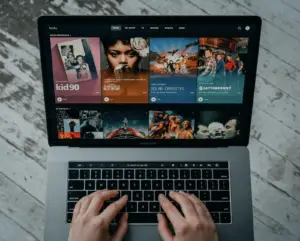
The dream of landing a Netflix deal once represented the holy grail for independent filmmakers. A streaming giant’s stamp of approval meant instant global distribution, substantial upfront payments, and the validation that comes with appearing alongside major studio releases. However, a growing number of indie creators are deliberately walking away from these traditional streaming partnerships, choosing instead to cultivate intimate, dedicated audiences through alternative distribution methods.
This shift reflects a fundamental change in how filmmakers view success. Rather than chasing massive viewership numbers that often get lost in algorithmic noise, many directors are prioritizing direct connections with viewers who genuinely appreciate their work. The result is a thriving ecosystem of micro-audiences that, while smaller in scale, offer significantly higher engagement and financial sustainability.
The Limitations of Traditional Streaming
Major streaming platforms operate on a volume-based model that often conflicts with the intimate nature of independent cinema. Films can disappear into vast content libraries, competing for attention against blockbuster series and algorithm-favored content. For many indie filmmakers, the experience of seeing their carefully crafted work reduced to a thumbnail in an endless scroll has become increasingly frustrating.
Moreover, traditional streaming deals often involve surrendering significant creative control and ownership rights. Filmmakers receive upfront payments but forfeit long-term revenue potential and the ability to build direct relationships with their audiences. This transactional approach leaves little room for the community-building that many artists crave.
The Rise of Curated Platforms
In response to these limitations, filmmakers are gravitating toward curated platforms that prioritize quality over quantity. Services like MUBI, Criterion Channel, and specialized genre platforms offer more selective programming that allows individual films to receive proper attention and context. These platforms actively promote their content through editorial features, filmmaker interviews, and thematic programming that helps viewers discover new work.
Vimeo has emerged as a particularly attractive alternative, offering filmmakers direct monetization options through its On Demand service. Unlike traditional streaming platforms, Vimeo allows creators to set their own pricing, maintain ownership of their content, and access detailed analytics about their audience. This model has proven especially appealing to documentary filmmakers and experimental artists who value creative freedom over mass distribution.
Direct Sales and Digital Patronage
The most significant trend involves filmmakers taking complete control of their distribution through direct sales and subscription models. Platforms like Filmhub enable creators to distribute their work across multiple channels while retaining ownership and receiving transparent revenue sharing. Some filmmakers have built their own websites, selling digital downloads or streaming access directly to supporters.
Digital patronage platforms like Patreon have revolutionized how independent creators fund their projects. Rather than relying on traditional financing methods, filmmakers can build sustainable income streams through monthly subscriptions from dedicated fans. This model allows for greater creative risk-taking since creators aren’t beholden to studio executives or platform algorithms.
The psychological appeal of exclusive access plays a crucial role in this model’s success. Supporters feel like insiders, receiving behind-the-scenes content, early access to new projects, and direct communication with creators. This intimate relationship fosters loyalty that traditional streaming platforms struggle to replicate.
Community-Driven Distribution
Perhaps the most innovative development involves filmmakers using social platforms to create immersive viewing experiences. Discord servers have become virtual screening rooms where filmmakers host live watch parties, providing real-time commentary and answering audience questions. These events transform passive viewing into interactive experiences that build lasting connections between creators and viewers.
Some filmmakers have partnered with gaming platforms to reach audiences through unexpected channels. The crossover between film and gaming culture has created unique opportunities, with some creators even exploring collaborations with entertainment platforms that offer movie themed online pokies and other interactive experiences, demonstrating how storytelling can extend beyond traditional formats.

The Economics of Micro-Audiences
While micro-audience strategies may seem financially limiting, many filmmakers report higher per-viewer revenue than traditional streaming deals. A dedicated audience of 5,000 supporters paying $10 monthly can generate $600,000 annually – often exceeding what emerging filmmakers receive from platform licensing deals.
This model also provides predictable income streams that enable better project planning. Instead of gambling on whether their next film will attract platform interest, creators can gauge audience demand for specific projects and adjust their production accordingly.
Building Sustainable Creative Careers
The shift toward micro-audiences represents more than just a distribution strategy; it’s a fundamental reimagining of creative careers in the digital age. By prioritizing depth over breadth, filmmakers can build sustainable businesses that support their artistic vision while maintaining creative independence.
Success in this model requires filmmakers to become entrepreneurs, managing not just the creative aspects of their work but also marketing, community building, and business development. While this additional responsibility can be overwhelming, many creators find it preferable to the uncertainty and lack of control inherent in traditional industry structures.
The future of independent cinema may lie not in competing for attention on crowded platforms, but in cultivating meaningful relationships with audiences who truly value artistic expression. As more filmmakers embrace this approach, we’re witnessing the emergence of a more diverse, sustainable, and creatively fulfilling entertainment landscape that prioritizes connection over consumption.

